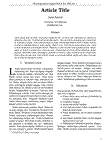Resultados de búsqueda - ((taxonomo OR (taxonomy OR taxonomia)) OR (taxonom OR (taxonomiaiay OR taxonomicas)))*
Materias dentro de su búsqueda.
Materias dentro de su búsqueda.
- México 4
- taxonomía 4
- Mexico 3
- Taxonomía 3
- biodiversidad 2
- política científica 2
- 16S rRNA 1
- Abies 1
- Amphibians 1
- América Central 1
- Anfibios 1
- Aplicación móvil 1
- Arrecifes de coral 1
- Autorregulación 1
- Barcodes of Life 1
- Biodiversity 1
- Biodiversity decline 1
- Caudata 1
- Central America 1
- Colecciones biológicas 1
- Community conservation 1
- Coníferas 1
- Cupressus 1
- Código de barra de la vida 1
- Derechos humanos 1
- Desarrollo Instruccional 1
- Diseño Instruccional 1
- Echinodermata 1
- Educación 1
- Enterobacteriaceae 1
-
101
Activos de aprendizaje organizacional un activo de conocimiento crítico
Publicado 2015“…La metodología a es fruto de los resultados de la investigación se basó en el uso de técnicas cualitativas lográndose exponer el concepto de activos de aprendizaje organizacional como un activo factor critico para el desempeño organizacional, se establecen además sus características, semejanzas y divergencias con otras taxonomías de activos de conocimiento. Los activos de aprendizaje organizacional son de gran importancia pues fortalecen las identidades de sus poseedores, potencian el intercambio de conocimiento y favorecen los flujos de conocimiento relacionados con los objetivos organizacionales.…”
Enlace del recurso
Artículo -
102
Sistemática, zoogeografía y evolución del género herichthys (pisces: cichlidae), en el noreste de México
Publicado 2014“…Se clarificó el estatus taxonómico de las especies dentro del género Herichthys, se describe un nuevo género, cuatro nuevas especies, y se desarrolló una propuesta taxonómica con fundamento en los conceptos de especie vigentes conforme al Código Internacional de Nomenclatura Zoológica en su edición de 1999.…”
Enlace del recurso
Tesis -
103
Sistemática, zoogeografía y evolución del género herichthys (pisces: cichlidae), en el noreste de México
Publicado 2014“…Se clarificó el estatus taxonómico de las especies dentro del género Herichthys, se describe un nuevo género, cuatro nuevas especies, y se desarrolló una propuesta taxonómica con fundamento en los conceptos de especie vigentes conforme al Código Internacional de Nomenclatura Zoológica en su edición de 1999.…”
Enlace del recurso
Tesis -
104
LOS LÍQUENES, SON PLANTAS?
Publicado 2024“…Químicamente se pueden distinguir porque producen uno o más de los 350 metabolitos secundarios, cuya presencia se emplean para su clasificación taxonómica, como fármacos, como tintes en la industria textil o como aromas o fijadores en perfumería. …”
Enlace del recurso
Artículo -
105
Efecto de la Dieta en el Microbioma Intestinal de Organismos Acuáticos
Publicado 2017“…Gracias a los recientes métodos de secuenciación masiva del ADN, se ha abiertouna ventana para explorar la composición taxonómica (microbiota) de los microorganismos no cultivables queexisten en todos los ecosistemas, y el intestinal no es la excepción. …”
Enlace del recurso
Artículo -
106
Influence of whole-wheat consumption on fecal microbial community structure of obese diabetic mice
Publicado 2016“…Almost 9,000 different bacterial species (Operational Taxonomic Units at 97% similarity) were detected in all mice but the bacterial diversity (number of OTUs) did not differ among the treatment groups. …”
Enlace del recurso
Artículo -
107
Biodiversidad de Coníferas del Estado de Nuevo León, México
Publicado 2021“…Tras una revisión bibliográfica y taxonómica, se encontró que en el estado de Nuevo León habitan 31 especies de coníferas pertenecientes a los géneros Abies, Cupressus, Juniperus, Picea, Pinus, Pseudotsuga, Taxodium, y Taxus. …”
Enlace del recurso
Artículo -
108
Biodiversidad de coníferas del Estado de Nuevo León, México
Publicado 2021“…Tras una revisión bibliográfica y taxonómica, se encontró que en el estado de Nuevo León habitan 31 especies de coníferas pertenecientes a los géneros Abies, Cupressus, Juniperus, Picea, Pinus, Pseudotsuga, Taxodium, y Taxus. …”
Enlace del recurso
Artículo -
109
Distributional and Ecological Notes on the Halfbeaks of Eastern Gulf of Mexico, with a Provisional Key for Their Identifification
Publicado 1997“…Most of it has centered around the taxonomic status of H. unifasciatus (including its synonym H. roberti), which is shown to comprise a complex of three species, H. unifasciatus, the recently described H. meeki, from the western Atlantic region, and an undescribed species from the eastern Pacific Ocean. …”
Enlace del recurso
Artículo -
110
First record of glycera guatemalensis and G. sphyrabrancha (Annelida: Glyceridae) from Western México
Publicado 2019“…Methods: An analysis of the glycerides of the Pacific coast of Mexico was carried out, finding two species that were collected, one of shrimp trawl at a depth of 18 meters off Puertecitos, Baja California, as well as by manual sampling in the intertidal zone of Concepción Bay, Baja California Sur in the Gulf of California. For their taxonomic determination, morphological characters of greater relevance for their identification were examined, such as jaws, aileron shape, parapodia, chaetae, and the type of pharyngeal papillae. …”
Enlace del recurso
Artículo -
111
Review of the Capitellidae (Annelida, Polychaeta) from the Eastern Tropical Pacific region, with notes on selected species
Publicado 2011“…The main objective of this work is to contribute to the taxonomic knowledge of the species of Capitellidae reported for the Eastern Tropical Pacific. …”
Enlace del recurso
Artículo -
112
The mycetoma knowledge gap: identification of research priorities
Publicado 2014“…Mycetoma is a tropical disease which is caused by a taxonomically diverse range of actinomycetes (actinomycetoma) and fungi (eumycetoma). …”
Enlace del recurso
Artículo -
113
Two new species of notodasus fauchald, 1972 (Annelida: Capitellidae) from the Central Indo-Pacific region
Publicado 2019“…The genus is unusual in the Central IndoPacific, and there is no taxonomic record of Notodasus in this region. In this study, two new species of Notodasus are described and illustrated, namely Notodasus celebensis sp. nov. and N. chinensis sp. nov. …”
Enlace del recurso
Artículo -
114
Microbiota gastrointestinal y síndrome de intestino irritable
Publicado 2014“…The differences in sequencing of these hypervariable regions make it possible to taxonomically identify the bacteria present in study samples (for example, in stools and intestinal mucosa).3 The «rrs» gene, also known as 16S ribosomal DNA or 16S rDNA, as mentioned in table 3 of our article, encodes 16S rRNA. …”
Enlace del recurso
Artículo -
115
New records of invasive tubeworms (Ficopomatus, Serpulidae) in Mexico
Publicado 2022“…Molecular genetics studies are needed to confirm the taxonomic and invasive status of F. uschakovi.…”
Enlace del recurso
Artículo -
116
Mesoamerican salamanders (Amphibia:Caudata) as a conservation focal group
Publicado 2021“…En términos generales, la importancia del recurso de biodiversidad representado por las salamandras mesoamericanas no es tomado en cuenta fuera de un pequeño grupo de herpetólogos y taxónomos interesados en la conservación del grupo en la región. …”
Enlace del recurso
Artículo -
117
Universal primers for the amplification and sequence analysis pf actin-1 from diverse mosquito species
Publicado 2010“…We report the development of universal primers for the reverse-transcription polymerase chain reaction (RT-PCR) amplification and nucleotide sequence analysis of actin cDNAs from taxonomically diverse mosquito species. Primers specific to conserved regions of the invertebrate actin-1 gene were designed after actin cDNA sequences of Anopheles gambiae, Bombyx mori, Drosophila melanogaster, and Caenorhabditis elegans. …”
Enlace del recurso
Artículo -
118
A new parrot taxon from the Yucatán Peninsula, Mexico—its position within genus Amazona based on morphology and molecular phylogeny
Publicado 2017“…However, taken together tree topology tests and morphometric analyses, we can conclude that the new parrot represents a recently evolving species, whose taxonomic status should be further confirmed. This lineage diverged from its closest relative about 120,000 years ago and was subjected to accelerated morphological and behavioral changes like some other representatives of the genus Amazona. …”
Enlace del recurso
Artículo -
119
-
120
Synopsis of the pelidnotine scarabs (Coleoptera, Scarabaeidae, Rutelinae, Rutelini) and annotated catalog of the species and subspecies
Publicado 2017“…These beetles suffer from a complicated nomenclatural history, due primarily to 20th century taxonomic and nomenclatural errors. We review the taxonomic history of the pelidnotine scarabs, present a provisional key to genera with overviews of all genera, and synthesize a catalog of all taxa with synonyms, distributional data, type specimen information, and 107 images of exemplar species. …”
Enlace del recurso
Artículo


